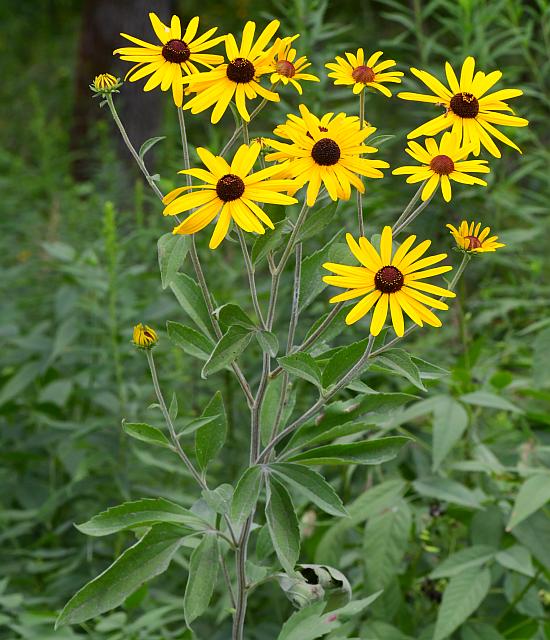Rudbeckia subtomentosa Pursh
Sweet Coneflower

Native
CC = 5
CW = 3
MOC = 57
© SRTurner
Rudbeckia subtomentosa PurshSweet Coneflower | |
 |
Native CC = 5 CW = 3 MOC = 57 |
© SRTurner |
|
Family - Asteraceae/Heliantheae Habit - Perennial forb with fibrous roots and stout rhizomes. Stems - Ascending to erect, to 2 m, branching above, moderately to densely pubescent with short, spreading hairs, at least above the midpoint.
Leaves - Alternate, petiolate, mostly deeply 3-lobed or deeply divided, mostly angled or tapered at the base, only slightly expanded at the base and inconspicuously wrapping around the stem, the margins otherwise sharply and finely to coarsely toothed, the surfaces (especially the undersurface) moderately to densely pubescent with short, spreading, minutely pustular-based hairs, often also minutely gland-dotted, moderately to strongly roughened to the touch, green to grayish green when fresh. Basal and lowermost stem leaves often absent at flowering, long-petiolate, the blade 15-30 cm long, 30-100 mm wide, ovate to broadly ovate or elliptic in outline, the lobes ovate to narrowly elliptic or lanceolate, tapered to a sharply pointed tip. Median and upper stem leaves short-to long-petiolate, the uppermost leaves occasionally sessile, the blade 2-20 cm long, 1-120 mm wide, the unlobed leaf blade or the lobes of a divided blade lanceolate to ovate to elliptic, tapered to a sharply pointed tip.
Inflorescences - Loose, open clusters or panicles of flower heads. Peduncles tomentose. Inflorescence divisions subtended by foliaceous bracts.
Heads - Radiate. Involucral bracts 15-25, 5-15 mm long, lanceolate to nearly linear, the outer surface and margins densely pubescent with short, usually minutely pustular-based hairs. Receptacle 10-17 mm long, 8-16 mm in diameter, usually hemispherical at the start of flowering, then elongating somewhat and becoming more or less conical. Chaffy bracts subtending only the disc florets, shorter than to nearly as long as the disc florets, angled to a short, usually sharply pointed tip, the outer surface and margins with dense, short, often somewhat matted hairs, dark purple toward the tip.
Flowers - Ray florets 12-20, sterile, the corolla 20-40 mm long, usually relatively slender, spreading or slightly drooping at flowering, yellow to orangish yellow, the outer surface sparsely short-hairy and moderately minutely gland-dotted. Disc florets numerous, perfect, the corolla 3.0-4.5 mm long, yellowish green toward the base, normally dark purple to purplish brown toward the tip, the lobes spreading to curled downward at flowering. Stigma lobes relatively short and usually sharply pointed at the tip. Pappus a minute rim or crown. Stamens 5, adnate at base of corolla tube. Anthers connate around style, purplish-brown, 1.3 mm long, slightly exserted from corolla. Style bifurcate, deep purple.
Flowering - July - October. Fruits - Achenes 2.0-3.5 mm long, glabrous, 4-angled. Habitat - Bottomland forests, edges of mesic upland forests, upland prairies, streambanks, pond margins, fens, pastures, ditches, railroads, roadsides. Origin - Native to the U.S. Lookalikes - Numerous other aster family plants, particularly R. hirta and R. triloba. Other info. - This is a fairly common plant throughout most of Missouri. Beyond Missouri it is mostly found in six other states, ranging from northern Illinois and Indiana southward through Louisiana. The plant is recognized by its tall stature, lobed leaves, and showy flower heads. The leaves are rough and somewhat stiff in texture, and much of the herbage is canescent (greyish due to hairiness). The plant strongly resembles black-eyed Susan (R. hirta), but that species does not have lobed leaves. Photographs taken at the Dorris Creek Prairie Conservation Area, Barton County, MO., 7-28-00 (DETenaglia); also at Shaw Nature Reserve, Franklin County, MO, 7-28-2006 and 8-4-2021, Weldon Spring Conservation Area, St. Charles County, MO, 8-14-2014, and Schuette Prairie, Polk County, MO, 8-6-2024 (SRTurner). |